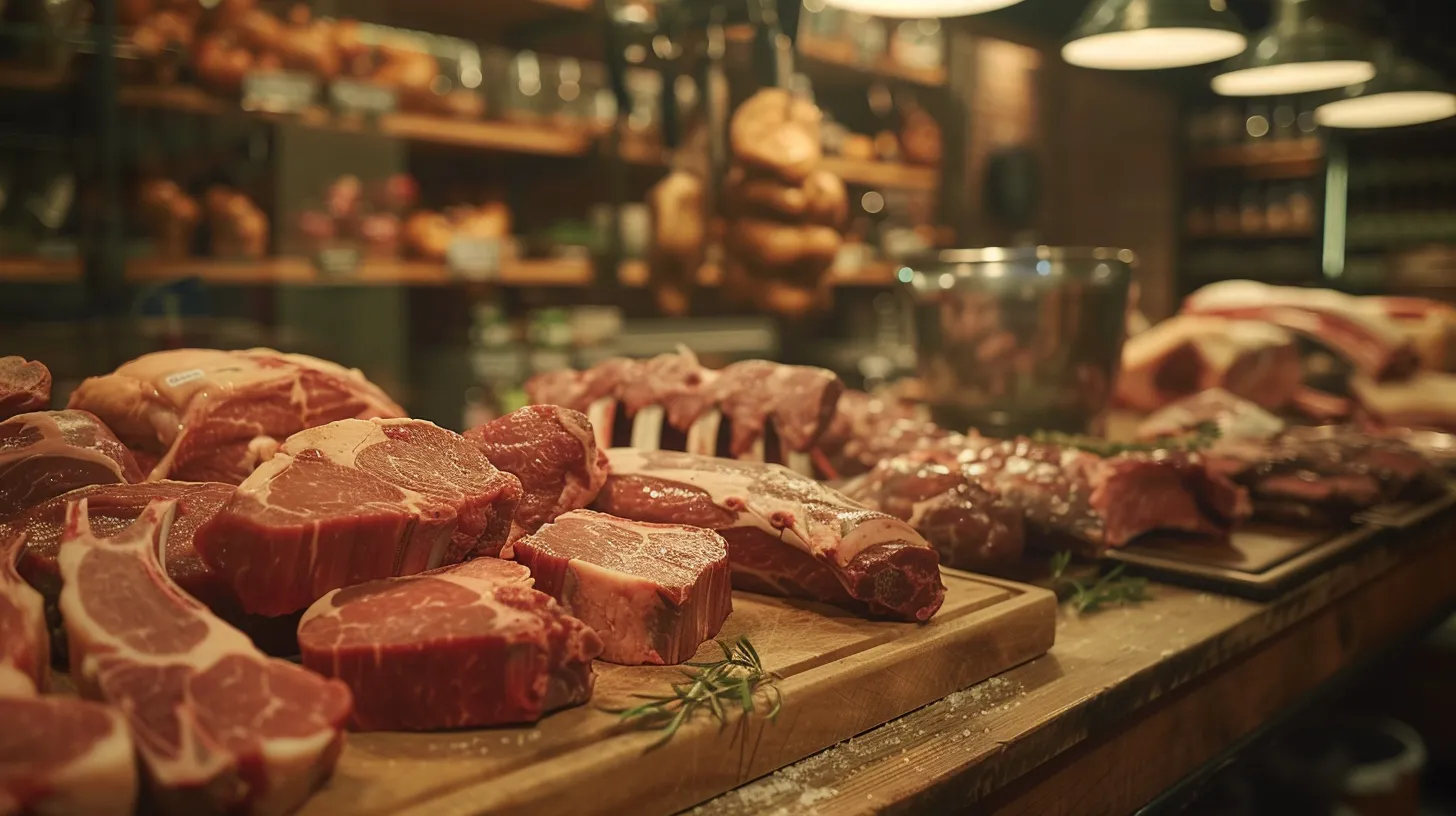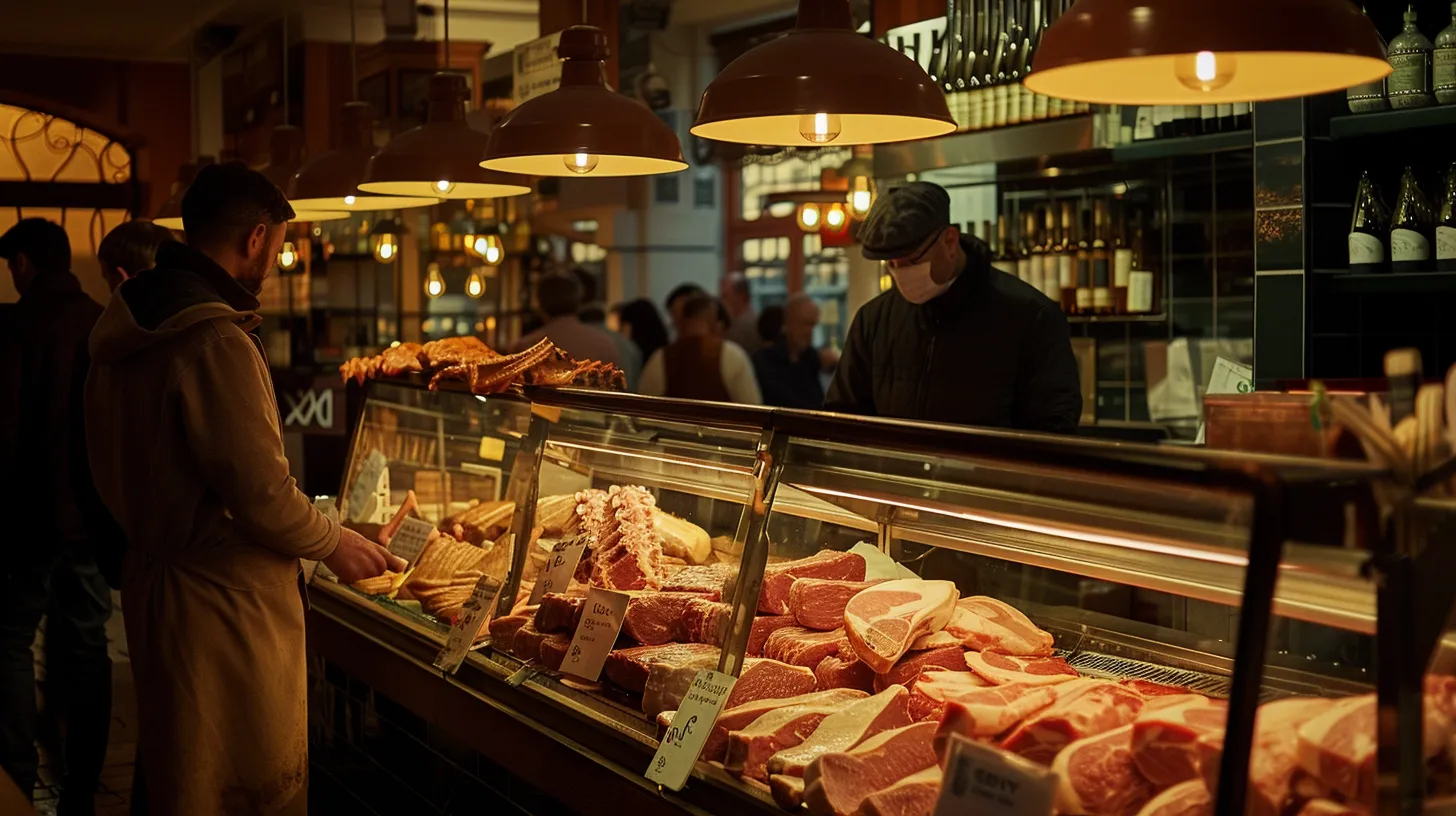Discover the Best Meat Market Near You Through Reviews
Finding the best meat market near you can be challenging, especially when quality and food safety are priorities. Recent reviews provide valuable insights into local options, revealing key aspects such as taste, selection, and service. This article will evaluate local meat markets based on customer feedback, addressing common concerns and highlighting top-rated establishments. By exploring these insights, readers can make informed choices that enhance their food system and ensure a satisfying shopping experience. This guidance aims to simplify the search for exceptional meat while emphasizing the importance of quality and nutrition.
Key Insights for Top Meat Markets
- quality and freshness are critical factors for consumers when choosing meat markets
- knowledgeable staff enhance customer experiences and build trust through personalized service
- sustainability practices play a significant role in consumer preferences for meat sourcing
- transparency in sourcing enhances customer confidence and loyalty in meat markets
- engaging with customer feedback is crucial for improving services and offerings
Understanding What Makes a Meat Market Exceptional

Key characteristics of outstanding meat markets begin with a focus on quality. Consumers assess the freshness and taste of meat products, which directly reflects the practices within the meat industry. Additionally, exceptional customer service is vital, fostering trust and loyalty among patrons. Sustainability practices and innovations in our specialties offerings also play significant roles in evaluation, enhancing overall experience and employment opportunities. When searching for a meat market near me, these factors are essential to consider.
Key Characteristics of Outstanding Meat Markets
Outstanding meat markets set themselves apart through a commitment to quality and freshness that resonates with today’s consumers. This emphasis is evident in the sourcing of meats, particularly pork, which should meet high standards for flavor and safety. By utilizing sensors to monitor storage conditions, meat markets can ensure optimal freshness and reduce the risk of pollution from improper handling, ultimately supporting the health of customers and their dietary choices.
Another characteristic of exceptional meat markets is the focus on customer experience. Knowledgeable staff can provide insights about various cuts and preparation methods, allowing customers to make informed decisions that align with their unique diets. Engaging displays and tastings help reinforce the importance of responsible consumption while showcasing a market’s diverse offerings:
- Commitment to quality and freshness
- Use of technology to ensure safe handling
- Knowledgeable and approachable staff
- Customer engagement through tastings and demonstrations
Assessing Quality in Meat Products
Quality assessment in meat products involves examining several factors, including the source of the meat and its packaging. Consumers should look for sustainable practices that ensure the meat is raised and processed responsibly. This focus on sustainability is becoming increasingly important as many individuals consider the environmental impact of their food choices, including the comparison between traditional meats and meat alternatives, which may provide equally satisfying options.
Another critical aspect of quality assessment is the tissue structure of the meat, which correlates with flavor and tenderness. When selecting meat, it is beneficial to consider its appearance, aroma, and the specifics of cooking methods recommended by knowledgeable staff. By understanding these elements, consumers can make informed choices that enhance their culinary experiences and support healthier dietary habits:
| Assessment Factor | Description |
|---|---|
| Source of Meat | Check for sustainable sourcing, ensuring responsible practices. |
| Packaging | Consider how meat is packaged to maintain freshness and reduce waste. |
| Tissue Structure | Assess the quality of meat based on its appearance and tenderness. |
| Cooking Methods | Advice from experts can guide optimal cooking practices. |
The Role of Customer Service in Meat Markets
Customer service plays a pivotal role in the success of meat markets, influencing consumer loyalty and repeat business. Effective policies that prioritize accessibility enable patrons to interact comfortably with staff, allowing them to inquire about prices, preparation methods, and product sourcing. Such engagement is vital, particularly when customers seek quality poultry or specialty cuts, ensuring they receive the best value for their purchases.
Statistics show that exceptional customer service can significantly enhance customer satisfaction and retention rates. For instance, knowledgeable staff who can address inquiries about sustainability practices or cooking techniques can create a positive shopping experience. By fostering a welcoming environment, meat markets can easily distinguish themselves as the preferred choice among consumers, effectively increasing foot traffic and sales.
| Aspect | Importance |
|---|---|
| Policy | Ensures a well-defined protocol for customer interactions. |
| Price | Competitive pricing fosters trust and promotes repeat purchases. |
| Accessibility | Aids customers in easily obtaining assistance and information. |
| Poultry | Quality poultry requires informed staff to guide selections. |
| Statistics | Data-driven insights highlight trends in customer satisfaction. |
Importance of Sustainability Practices
Sustainability practices in meat markets are increasingly essential as consumers seek to make informed choices about their food sources. Those committed to responsible sourcing and livestock management can leverage biotechnology and research to enhance the safety and quality of products like sausage and ground beef. By prioritizing sustainability, these markets demonstrate a dedication to not only environmental stewardship but also to the health of their patrons.
For users looking to find the best meat market, considering sustainability can offer insights into the quality of offerings. Markets that emphasize eco-friendly practices often provide transparency about their supply chains, ensuring that products are ethically raised and processed. This information can significantly enhance a consumer‘s confidence in their purchases, fostering loyalty to businesses that align with their values and dietary preferences.
Innovations in Meat Market Offerings
Innovations in meat market offerings are transforming how consumers access quality products. Markets that emphasize transparency and open access to information about livestock production are better equipped to address customers’ nutritional concerns. By adopting advanced tracking systems, they can minimize hazards associated with food safety and provide assurance of high-quality meats.
Additionally, markets showcasing their specialties, such as unique cuts or specialty sausages, often attract discerning shoppers looking for culinary inspiration. By highlighting these innovations, meat markets not only enhance the customer experience but also promote responsible consumption, encouraging shoppers to explore the diverse possibilities that quality meats offer.
| Innovation Type | Description |
|---|---|
| Transparency | Open access to information regarding livestock sourcing and production practices. |
| Quality Assurance | Adopting technology to track and ensure food safety, reducing hazards. |
| Specialty Products | Featuring unique and innovative cuts that cater to customer culinary interests. |
A good meat market earns its reputation through quality and service. Now, it is time to see how local markets stack up based on what recent customers have to say.
Evaluating Local Meat Markets Based on Recent Reviews

Analyzing consumer feedback sheds light on the reliability of local meat markets, influencing perceptions of food security within the food industry. Popular meat products among shoppers, particularly beef, can reveal trends in quality and preferences. By comparing pricing strategies, consumers can assess value while identifying unique offerings that set local markets apart. Utilizing review platforms effectively enables informed decisions in this competitive agriculture sector.
Analyzing Consumer Feedback and Its Impact
Consumer feedback serves as a vital resource for anyone searching for a reputable meat market near them. Understanding the nuances of quality, freshness, and service can reveal which markets excel in these areas and which may need improvement. By leveraging the collective knowledge of previous customers, individuals can make informed decisions that align with their preferences and dietary needs, ensuring their choices reflect their values in food sourcing and preparation.
Incorporating insights from biology, such as fermentation processes or cellular structure in meat products, further enhances the understanding of meat quality. Reviews can highlight how markets attend to these scientific principles in their offerings, especially in terms of sustainability and safety. This practical knowledge not only fosters consumer confidence but also encourages exploration of specialty products available at local meat markets.
| Feedback Category | Impact on Consumer Choices |
|---|---|
| Quality of Meat | Directly influences customer satisfaction and repeat visits. |
| Service Levels | Encourages loyalty through positive shopping experiences. |
| Sustainability Practices | Informs customers about the ethical sourcing of products. |
Highlighting Popular Meat Products Among Shoppers
In the quest to find the best meat market, shoppers often gravitate toward popular meat products that align with their culinary preferences. Favorites such as high-quality beef cuts, fresh poultry, and artisanal sausages frequently dominate consumer reviews, reflecting the expectations for flavor, tenderness, and sourcing practices. Markets that prioritize transparency in their offerings tend to attract discerning customers, as they showcase the origins and preparation methods of these appreciated products.
Recent reviews indicate a growing interest in specialty items like marinated meats and grass-fed options. Consumers seek markets that provide unique culinary experiences, and positive feedback often highlights the availability of these sought-after choices. Shoppers benefit from exploring local meat markets that emphasize popular products, ultimately leading them to quality meats that enhance their dining experiences and satisfy their dietary needs.
Comparing Pricing Strategies for Value Assessment
When evaluating local meat markets, comparing pricing strategies plays a crucial role in determining overall value. Customers should consider not only the prices but also the quality of the products offered. Markets that frequently adjust their prices based on seasonal availability or special promotions often provide competitive options, enhancing customer satisfaction while supporting diverse culinary needs. Reviews can highlight how these pricing strategies influence purchasing decisions, allowing consumers to make informed evaluations of value per dollar spent.
Furthermore, customer feedback frequently reveals insights into the perceived value across different meat categories. Markets that transparently communicate pricing alongside quality assurance tend to foster trust among consumers. By examining reviews that address both the affordability and quality of meat products, individuals can identify which local markets effectively balance these factors, ensuring they receive premium products without overspending.
Identifying Uniqueness in Local Market Offerings
Identifying uniqueness in local market offerings can guide consumers toward the ideal meat market that meets their culinary needs. Each market may showcase specialty products, such as house-made sausages or premium cuts, which are determined by the standards and expertise of the staff. Understanding these distinctive attributes can lead patrons to make informed decisions that enhance their dining experiences.
Recent reviews often highlight unique selling points that distinguish one market from another, such as sourcing practices or exclusive products. For instance, some markets may emphasize farm-to-table offerings or sustainable livestock practices, enhancing consumer trust and satisfaction. By evaluating these aspects through customer feedback, individuals can pinpoint the markets that align best with their preferences and values:
- Specialty products like artisanal sausages or unique cuts.
- Emphasis on quality sourcing practices and sustainability.
- Distinctive services that enhance the overall shopping experience.
Using Review Platforms Effectively
Using review platforms effectively allows consumers to gain valuable insights into local meat markets. When potential customers examine reviews, they should focus on comments regarding quality, freshness, and customer service, which are critical indicators of an exceptional meat market. This approach not only aids in identifying standout establishments but also highlights common customer experiences that can influence purchasing decisions.
Engagement with review platforms also provides an opportunity to compare specific offerings and prices among different meat markets. Users can evaluate the popularity of certain products, such as specialty sausages or organic cuts, based on consumer feedback. By synthesizing this information, individuals can confidently select a meat market that aligns with their culinary preferences and values, ensuring an informed and satisfying shopping experience.
The opinions of customers paint a vivid picture of local meat markets. Next, the approach taken to uncover their truths will be laid bare.
Methodology for Recent Evaluations of Meat Markets

When evaluating meat markets, several criteria come into play, including quality, freshness, and customer service. The process involves gathering relevant marketplace data, verifying quality claims, and utilizing tools to track and analyze consumer reviews. Engaging with customers for insightful feedback ensures a comprehensive understanding of their experiences and preferences, ultimately guiding consumers toward the best local meat markets.
Criteria for Evaluating Meat Markets
When evaluating meat markets, key criteria include quality, freshness, and customer service. Shoppers should seek out markets that consistently offer high-quality meats, as the sourcing and handling practices directly impact taste and safety. Freshness can often be determined by visual inspection and the aromas associated with the products, which are crucial factors in ensuring a satisfying purchase.
Another important aspect is the level of customer service provided, which significantly influences the overall shopping experience. Knowledgeable staff who can readily answer questions about product sourcing and preparation techniques add a layer of assurance for consumers. Positive reviews highlighting attentive service can guide individuals to markets where they can expect a superior shopping experience and make informed decisions about their meat selections.
Steps Involved in Gathering Marketplace Data
Gathering marketplace data begins with identifying reliable sources of information, such as online review platforms and social media feedback. These platforms provide valuable insights from customers who share their experiences at local meat markets. By analyzing reviews, shoppers can discern patterns regarding quality, freshness, and customer service, which helps pinpoint the best options available in the area.
Next, it is essential to compile this information systematically. This involves creating a database or spreadsheet that categorizes feedback based on various criteria, such as product quality, service ratings, and price competitiveness. By organizing data in this manner, consumers can effectively compare different meat markets side by side and identify those that consistently meet their expectations:
| Criteria | Importance |
|---|---|
| Product Quality | Determines customer satisfaction and repeat purchases. |
| Service Ratings | Reflects the shopping experience and staff knowledge. |
| Price Competitiveness | Affects perceived value and encourages purchases. |
Approaches to Verifying Quality Claims
Verifying quality claims in meat markets requires a systematic approach. Shoppers should seek information about sourcing practices, including whether the meat is ethically raised and conforms to health and safety regulations. Engaging with knowledgeable staff during visits can also provide insights into the quality measures taken by the market, giving consumers confidence in their selections.
Reviews from other customers serve as a vital resource in this evaluation process. Potential buyers can focus on feedback regarding specific meat products, such as freshness and flavor, which are strong indicators of quality. By synthesizing this information, shoppers can identify markets that consistently meet high standards and align with their culinary needs:
| Verification Method | Description |
|---|---|
| Employee Knowledge | Staff insights about sourcing and quality resilience. |
| Customer Reviews | Analyzing feedback regarding specific products and experiences. |
| Sourcing Practices | Evaluating claims related to ethical and sustainable practices. |
Tools to Track and Analyze Consumer Reviews
Effective tools for tracking and analyzing consumer reviews play a vital role in identifying the best meat market in the local area. Online platforms like Yelp and Google Reviews offer valuable insights from patrons, highlighting their experiences with quality, freshness, and overall customer service. By monitoring these reviews closely, prospective shoppers can discern patterns that indicate which establishments consistently meet high standards, ensuring that their meat selections align with personal preferences and dietary needs.
Additionally, advanced analytics tools can aggregate feedback across various platforms, allowing consumers to quickly access comprehensive assessments of local meat markets. By analyzing ratings and comments, these tools provide an overview of popular products and services, empowering shoppers to make informed choices. For those committed to sourcing high-quality meat, leveraging these tools can enhance their shopping experience and promote deeper engagement with reputable markets in their vicinity.
Engaging With Customers for Insightful Feedback
Engaging with customers to gather insightful feedback is essential for evaluating the quality of local meat markets. By encouraging open communication, businesses can learn directly from consumers about their preferences and experiences, providing valuable data for improvements. For instance, inviting patrons to share their opinions on the freshness of meats or customer service can significantly enhance the market’s offerings and ensure they meet community expectations.
Moreover, actively seeking feedback fosters a sense of community and trust between the market and its customers. Market owners can implement simple methods such as surveys or comment cards, allowing shoppers to voice their opinions and suggestions. This not only aids in identifying areas for enhancement but also reinforces customer loyalty, as patrons feel their insights are valued and considered in shaping the market’s future.
The numbers tell a story of quality and trust. Now, let’s turn our attention to the top-rated meat markets that bring this promise closer to home.
Spotlight on Top-Rated Meat Markets Near You

This section provides an overview of highly rated local meat markets, showcasing testimonials from satisfied customers that highlight unique features of each establishment. Trends observed across top-rated markets reveal insights into consumer preferences, while community involvement plays a significant role in enhancing ratings and fostering loyalty. Each aspect emphasizes the value of customer feedback in discovering the best meat market options.
Overview of Highly Rated Local Meat Markets
Local meat markets that receive high ratings often prioritize quality and customer satisfaction, reflecting their commitment to outstanding service and product excellence. Customers frequently praise establishments that offer real-time updates on freshness and sourcing, ensuring their meat selections meet both culinary and ethical standards. By leveraging consumer reviews, shoppers can identify markets that consistently deliver exceptional products, making their choices easier and more informed.
Many top-rated meat markets are known for their knowledgeable staff, who provide insights about various cuts and preparation techniques. This expertise not only helps customers make informed decisions but also builds a rapport that fosters loyalty. As consumers increasingly seek quality meats that align with their lifestyle choices, selecting highly-rated markets can enhance their overall shopping experience and culinary endeavors.
Testimonials From Satisfied Customers
Satisfied customers often share their positive experiences at top-rated meat markets, highlighting the quality of products and the expertise of the staff. Patrons frequently commend the knowledgeable butchers who offer personalized recommendations tailored to specific culinary needs, making the shopping experience both enjoyable and efficient. Testimonials emphasize the freshness of the meats and unique cuts available, underscoring the importance of choosing a reliable establishment for superior meat selections.
Additionally, reviews consistently mention the welcoming atmosphere of these markets, where customer service thrives. Clients appreciate the willingness of staff members to engage in discussions about sourcing practices and preparation techniques, fostering a sense of trust and loyalty. These positive interactions contribute to a community-focused environment, further encouraging shoppers to return for their meat needs.
Unique Features of Each Highlighted Market
Each top-rated meat market displays unique features that cater to the various needs of customers. For instance, some establishments emphasize their commitment to local sourcing, offering meats that are ethically raised and processed within the community. This not only provides transparency but also fosters a sense of trust among consumers who prioritize sustainability in their purchases.
Another market might stand out due to its knowledgeable staff who offer personalized assistance and cooking tips tailored to individual dietary preferences. Such expertise enhances the shopping experience, allowing customers to confidently choose the right cuts for their culinary endeavors. The combination of these distinctive attributes makes each market a valuable resource in discovering high-quality meat options that resonate with consumer values and tastes:
| Market Feature | Description |
|---|---|
| Ethical Sourcing | Emphasis on local and responsibly-raised meat products. |
| Knowledgeable Staff | Personalized assistance and cooking tips for informed selections. |
Trends Observed Across Top-Rated Markets
Recent reviews of top-rated meat markets reveal a growing consumer preference for quality assurance and transparency in sourcing practices. Shoppers increasingly seek establishments that provide clear information about where their meat originates, focusing on ethical and sustainable practices. This trend underscores the importance of markets maintaining open communication about their sourcing, as it builds trust and loyalty among customers.
Another noticeable trend is the emphasis on personalized customer service, where knowledgeable staff play a crucial role in enhancing the shopping experience. Customers appreciate butchers who offer tailored recommendations and cooking tips that cater to individual preferences. By actively engaging with patrons, top-rated meat markets not only foster community but also create a welcoming environment that encourages repeat visits and positive word-of-mouth referrals.
Community Involvement and Its Impact on Ratings
Community involvement significantly contributes to the reputation and ratings of local meat markets. Markets that actively engage with their neighborhoods, such as sponsoring local events or supporting nearby farms, create a sense of trust and loyalty among consumers. When shoppers see a market’s commitment to community welfare, they are more likely to choose that establishment for their meat purchases, leading to higher ratings and positive reviews.
Moreover, involvement in community initiatives fosters relationships between meat markets and their customers, enhancing customer satisfaction. Engaging in educational workshops or cooking demonstrations not only showcases the quality of products but also equips consumers with knowledge about meat preparation. This direct interaction helps to build a loyal customer base, resulting in more favorable ratings and reviews reflective of a quality shopping experience:
| Community Involvement Type | Impact on Ratings |
|---|---|
| Sponsoring Local Events | Builds trust and loyalty among customers. |
| Supporting Local Farms | Enhances perception of quality and sustainability. |
| Conducting Workshops | Increases customer satisfaction and knowledge. |
Finding the right meat market can feel like a hunt. Next, it’s essential to address the common concerns that shape your choices and ensure the quality you expect.
Addressing Common Concerns in Meat Market Evaluations

When evaluating meat markets, consumers often have common concerns that can influence their decisions. Understanding the expected quality of meat is essential, as is navigating pricing strategies to assess overall value. Supply chain transparency can reveal sourcing practices, while accommodating dietary preferences and special requests enhances the shopping experience. Furthermore, ensuring safety and hygiene standards is crucial for consumer confidence.
Each of these topics provides practical insights into what shoppers should consider when selecting a meat market. By addressing these concerns, consumers can make informed choices that align with their needs and values, ultimately leading to a satisfying purchasing experience.
Managing Expectations With Meat Quality
Managing expectations regarding meat quality involves understanding the specific attributes that define superior products. Consumers should consider factors such as freshness, sourcing, and storage practices, which directly impact the taste and safety of the meat. By reviewing feedback from previous patrons, individuals can better gauge the commitment of local meat markets to provide high-quality options that align with their culinary standards.
Additionally, clear communication with knowledgeable staff can help clarify any uncertainties related to meat quality. Customers are encouraged to ask questions about preparation methods, recommended cooking times, and the overall care taken in handling meats. This dialogue not only enhances customer satisfaction but also ensures that shoppers feel confident in their selections, ultimately leading to a better dining experience.
Navigating Pricing Concerns and Value Perception
Navigating pricing concerns in meat markets requires understanding how prices reflect quality and sourcing practices. Consumers should recognize that higher prices often correlate with ethically sourced meats and superior handling processes. By comparing prices across different local markets through online reviews, shoppers can align their budget with the quality they expect, ensuring they receive good value for their purchases.
Moreover, transparency in pricing helps consumers feel confident about their selections. Market reviews often mention whether meat prices are fair for the quality offered. By paying attention to feedback about pricing strategies, individuals can find establishments that deliver high-quality meats while prioritizing affordability and value:
| Pricing Strategy | Description |
|---|---|
| Seasonal Pricing | Adjusting prices based on meat availability enhances competitiveness. |
| Promotions | Offering deals on bulk purchases increases customer engagement. |
| Transparency | Clear pricing helps build trust in the quality of products. |
Understanding Supply Chain Transparency
Supply chain transparency is crucial for consumers seeking to understand where their meat comes from and how it is handled. Markets that openly share their sourcing practices often instill greater consumer confidence. Shoppers can feel assured that their choices align with their values, particularly when it involves ethically raised livestock and sustainable practices.
Consumers benefit from markets that provide clear information about their supply chains, including details on producer relationships and transportation methods. Such transparency not only helps patrons evaluate quality and safety but also connects them to responsible food production. This connection enhances the overall shopping experience as consumers increasingly prioritize knowledge and sustainability in their meat selections.
Handling Dietary Preferences and Special Requests
When seeking a local meat market, handling dietary preferences and special requests can significantly enhance the shopping experience. Customers often appreciate establishments that accommodate individual needs, such as offering specialty diets like gluten-free or low-fat options. Knowledgeable staff at these markets can provide personalized recommendations that cater to these dietary requirements, creating a welcoming environment that encourages repeat visits.
Additionally, many consumers value the ability to request specific cuts or preparations of meat, which adds to the overall convenience of their shopping experience. Markets that are flexible in meeting such requests can foster customer loyalty and trust. By actively listening to patrons and responding to their unique preferences, reputable meat markets can effectively address the needs of their community, ensuring that shoppers leave satisfied with their purchases.
Ensuring Safety and Hygiene Standards
Ensuring safety and hygiene standards is critical for consumers when evaluating local meat markets. A clean and well-maintained environment demonstrates a market’s commitment to delivering high-quality products. Shoppers should look for establishments that adhere to health regulations and maintain proper sanitation practices, as these factors are essential for minimizing the risk of foodborne illnesses and ensuring meat quality.
Moreover, knowledgeable staff at reputable meat markets can provide detailed information about their hygiene practices. Consumers should feel empowered to ask questions regarding how meats are handled, stored, and prepared. This proactive approach not only fosters trust but also helps shoppers make informed decisions that align with their health and dietary priorities when selecting the best meat market nearby.
The meat market stands at a crossroads. As concerns shift, new trends begin to emerge, shaping the future of how consumers evaluate their choices.
Future Trends in Meat Market Evaluations

Technology is increasingly shaping market assessments, enabling consumers to evaluate local meat sources effectively. As consumer preferences evolve, there is a stronger emphasis on sustainability and ethical sourcing. Insights gained from evaluations can shift buying behaviors, leading to increased demand for transparency in meat markets. This analysis will explore these trends and their implications for the future landscape of meat sourcing.
The Impact of Technology on Market Assessments
Technology plays a crucial role in modern meat market assessments, enabling consumers to evaluate local options effectively through online reviews and feedback. With platforms like Yelp and Google Reviews, potential customers can access real-time insights into quality, freshness, and customer service, helping them make informed decisions. As shoppers increasingly rely on these technological tools, markets are encouraged to maintain high standards to meet consumer expectations.
Furthermore, advancements in tracking and data analytics allow meat markets to monitor consumer preferences and trends. By analyzing feedback from various sources, markets can better understand the demands for specific cuts or sustainable practices. This technology-driven approach not only enhances quality control but also strengthens relationships between markets and patrons, fostering a more responsive and customer-focused shopping experience.
Evolving Consumer Preferences in Meat Selection
Consumer preferences in meat selection are shifting as individuals increasingly seek higher quality and ethically sourced options. Today’s shoppers are more informed, prioritizing freshness, sustainability, and the origins of their meat products. Markets that highlight transparent sourcing practices and offer organic or grass-fed options are more likely to attract discerning customers who value these attributes in their culinary choices.
Moreover, the rise of meat alternatives has prompted traditional meat markets to adapt their offerings. Many consumers are exploring diverse culinary experiences, seeking specialty cuts, marinated options, and unique preparations. This evolution encourages markets to showcase their expertise, engage with customers through education, and remain flexible to the changing needs of their clientele in an ever-competitive landscape:
- Shift towards ethically sourced and high-quality meat products.
- Growing interest in specialty cuts and unique preparations.
- Markets that emphasize transparency are more appealing to shoppers.
Sustainability and Ethical Sourcing in Focus
Sustainability and ethical sourcing have become essential focal points for consumers evaluating local meat markets. As awareness of environmental issues grows, shoppers increasingly seek markets that prioritize responsible sourcing practices. These establishments often disclose their methods of raising livestock, ensuring that both animal welfare and ecological considerations are met, which enhances consumer confidence and satisfaction.
Proactive meat markets use transparent sourcing strategies to attract conscientious consumers. By clearly communicating their commitment to sustainability, these markets effectively address the growing demand for ethically sourced products. This approach not only fulfills consumer expectations but also fosters loyalty among patrons who appreciate knowing where their food originates and how it impacts their health and environment.
Predictions for Local Meat Market Landscape
The local meat market landscape is poised for significant transformations as consumer awareness of sustainable practices grows. Markets that prioritize ethical sourcing are expected to gain an edge, catering to a clientele that increasingly values transparency in the supply chain. By implementing responsible practices, these establishments can not only enhance their reputation but also foster loyalty among patrons seeking high-quality products that align with their values.
Additionally, technology is set to reshape how consumers evaluate and interact with meat markets. The rise of online reviews and social media feedback will continue to influence buying decisions, making it essential for markets to maintain high standards for quality and service. Harnessing these digital tools to engage with customers and respond to feedback will enable meat markets to adapt effectively to evolving preferences and ensure they remain competitive in the ever-changing food landscape.
Shifts in Consumer Behavior Post-Evaluation Insights
As consumers increasingly rely on online reviews to make informed decisions about meat markets, their behavior reflects a desire for quality and transparency. Shoppers are more likely to choose markets that prioritize customer feedback and demonstrate a commitment to ethical sourcing and freshness. This shift highlights the importance of customer reviews in shaping perceptions, leading individuals to patronize establishments that align with their culinary preferences and values.
The insights gained from evaluations not only guide consumer choices but also influence their expectations regarding product quality and service. Meat markets that actively engage with feedback can adjust their offerings to better meet customer needs, fostering loyalty and repeat business. This evolving dynamic emphasizes the critical role of transparency and customer interaction in the meat market landscape, ultimately enhancing the overall shopping experience for discerning consumers.
Conclusion
Finding the best meat market nearby through reviews is essential for ensuring quality and satisfaction in meat purchases. By leveraging consumer feedback, shoppers can assess aspects such as freshness, sourcing practices, and customer service, ultimately leading to informed decisions. Engaging with reviews not only highlights popular products but also promotes transparency and trust in local establishments. Prioritizing these insights allows consumers to select markets that align with their culinary preferences and values, enhancing their overall shopping experience.

